In drone survey missions, the choice between photogrammetry and LIDAR depends heavily on the exact application. You also need to consider operational factors, such as cost and complexity. Knowing what outputs you really need will help you make the right decision.
What is LIDAR and how does its output compare with results obtained with high-resolution RGB cameras and photogrammetry? In this article, we’ll explore the ways photogrammetry and LIDAR are actually quite different from each other, even if their three-dimensional (3D) outputs look similar. We’ll then dig deeper into specific applications and how photogrammetry can provide exceptional results for most missions at a fraction of the cost and complexity of LIDAR.
Photogrammetry and professional, high-resolution cameras can cost-effectively generate 2D and 3D surveys, with absolute accuracies down to 1 cm (0.4 in) root mean square (RMS) horizontal and 3 cm (1.6 in) RMS vertical.
How Photogrammetry Works
In photogrammetry, a drone captures a large number of high-resolution photos over an area. These images overlap such that the same point on the ground is visible in multiple photos and from different vantage points. In a similar way that the human brain uses information from both eyes to provide depth perception, photogrammetry uses these multiple vantage points in images to generate a 3D map.
The result: a high-resolution 3D reconstruction that contains not only elevation/height information, but also texture, shape, and color for every point on the map, enabling easier interpretation of the resulting 3D point cloud.
Drone systems that use photogrammetry are cost effective and provide outstanding flexibility in terms of where, when, and how you capture 2D and 3D data.
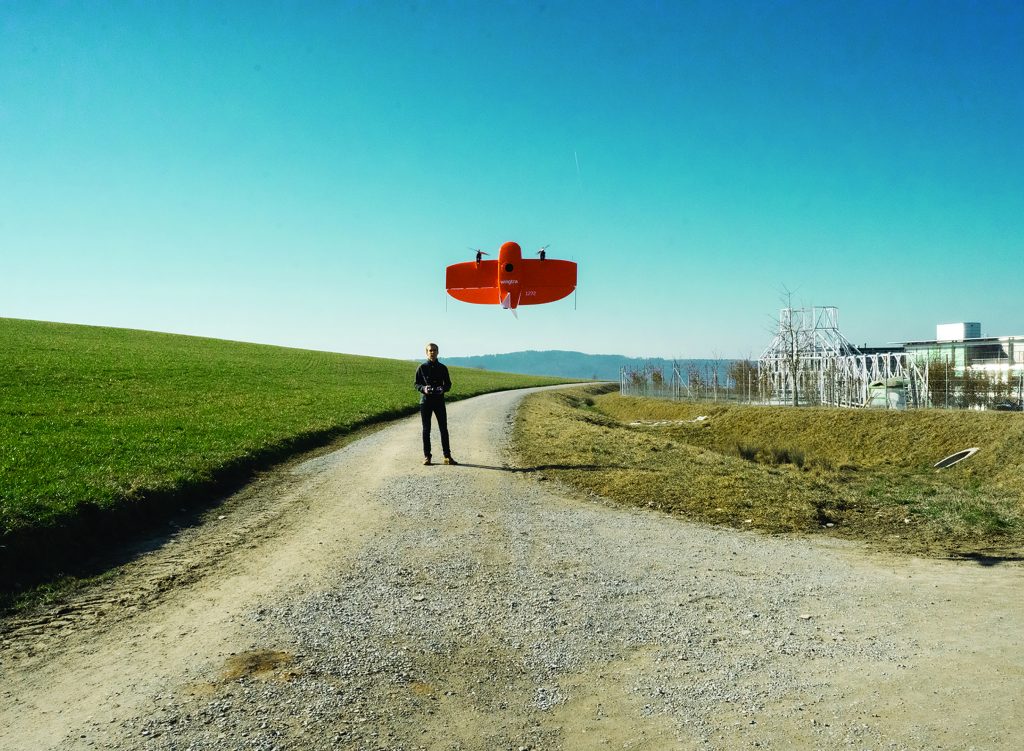
The WingtraOne vertical take-off and landing (VTOL) drone allows users to conduct small- and large-scale drone surveys with unmatched data quality at a fraction of the time and cost of a crewed aircraft.
HOW LIDAR WORKS
LIDAR, which stands for “light detection and ranging,” is a technology that has been around for many decades but has only recently been available in a size and power feasible for carrying on large drones. A LIDAR sensor sends out pulses of laser light and measures the exact time it takes for these pulses to return as they bounce from the ground. It also measures the intensity of that reflection.
LIDAR uses oscillating mirrors to send out laser pulses in many directions so as to generate a “sheet” of light as the drone moves forward. Through measuring the timing and intensity of the returning pulses, it can provide readings of the terrain and of points on the ground.
The sensor itself is only one part of a LIDAR system. Critically important for capturing usable data, you’ll also need a high-precision satellite positioning system (GNSS) as well as high-accuracy sensors to determine the orientation of the LIDAR sensor in space—an inertial measurement unit (IMU). All of these high-end subsystems must work in perfect orchestration to enable processing of the raw data into usable information, a process called direct geo-referencing.
As the sensors have evolved, there’s now the option to capture aerial LIDAR data from one of two types of systems: classical manned airborne and lightweight UAV.
Classical airborne LIDAR surveys are conducted from a crewed airplane and are less accurate but capable of covering more ground than lightweight UAV LIDAR operations. Specifically, you can cover between 10 and 1,000 square kilometers (4 and 400 square miles) in one flight. The absolute accuracy depends on the flight height and sensor choice. At a typical flight height of 2,000 meters (6,600 feet) above ground level (AGL), you can expect an absolute accuracy limit of about 20 cm (8 inches) horizontal and 10 cm (4 inches) vertical.
Lightweight drone LIDAR systems cover as much as the drone allows per flight. As we will discuss in detail in below sections, these systems can be more accurate than those carried by manned aircraft. Specifically, fixed-wing drones carrying a LIDAR payload can cover up to 10 square km (4 square miles) in a flight, with absolute accuracy limits right around 10 cm (4 inches) horizontal and 5 cm (2 inches) vertical.
In both cases of crewed aircraft and lightweight drone LIDAR, the accuracy is significantly less than photogrammetry avails. Plus the post-processing for LIDAR absolutely requires expertise beyond a quick training or reading of a manual, as we’ll discuss below.
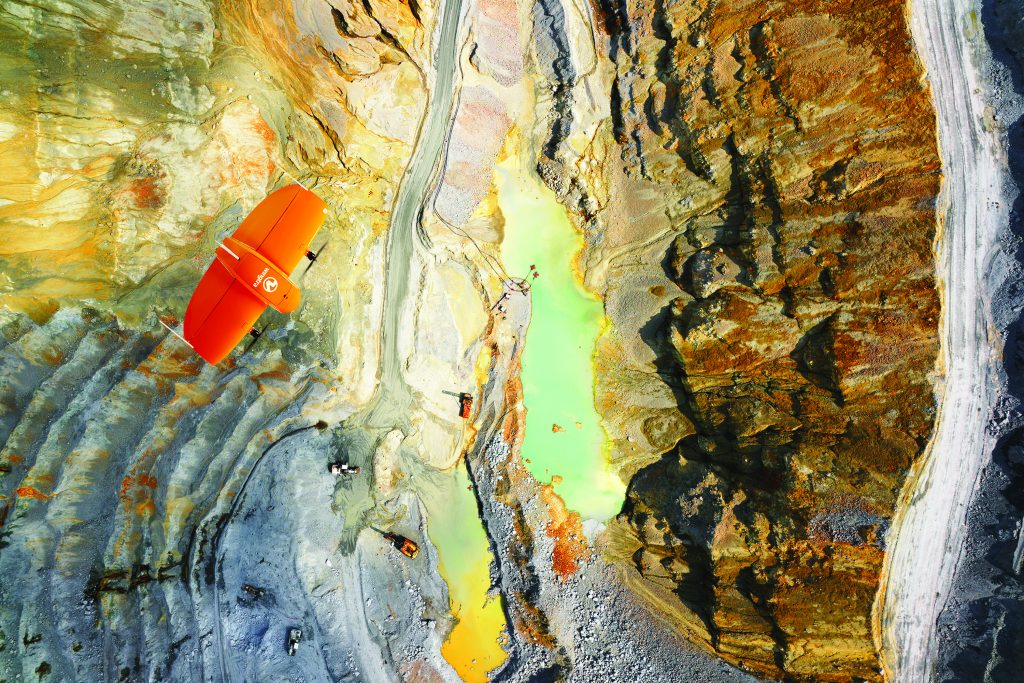
A WingtraOne UAV equipped with a LIDAR sensor can create accurate 3D models with 2 to 3 cm (0.8 to 1.2 in) of vertical accuracy. These models can be used for precise volumetric calculations across a number of industries.
ACCURACY CONSIDERATIONS
As we have seen, photogrammetry and aerial LIDAR differ in the way points on the ground are registered. This directly affects the final point cloud accuracy and we will see that, especially for horizontal accuracy of areas free from dense forest canopy, photogrammetry clearly outperforms aerial LIDAR.
Photogrammetry. In the case of photogrammetry, a quality, high-resolution, full-frame sensor camera like WingtraOne’s Sony RX1R II can yield outputs with horizontal (x-y) accuracies in the range of 1 cm (0.4 in) and elevation (z) accuracies in the range of 2 to 3 cm (0.8 to 1.2 inches) over hard surfaces, enabling precise volumetric analysis.
Note, however, that in order to achieve such performance the payload used for photogrammetry must be a professional one, with the right image sensor and lens to capture more detail. It’s not just about the number of pixels. In fact, two cameras with the same number of megapixels and different size sensors provide different image quality and accuracy.
Proper mission planning and post-processing are also important for achieving optimal accuracy: good overlap among images increases accuracy and provides better error correction compared to complete reliance on the direct geo-referencing method used in LIDAR. A high-end drone system with professional mission planning and post-processing workflow helps ensure that you capture quality data that generates accurate results.
LIDAR. As for aerial LIDAR methods, the sensor does not target specific features on ground but instead shoots the beams at a set frequency in a defined pattern. Even if the horizontal accuracy of the single point might be higher, the best horizontal accuracy of a point of interest on the ground is limited by the point density.
Crewed aerial LIDAR can provide a point density of up to 50 points per square meter and offers a typical absolute accuracy of 20 cm horizontal and 10 cm vertical if flown at a standard height of 2,000 meters (6,600 feet) AGL.
By flying lower, lightweight UAV LIDAR provides a higher point density than crewed aerial LIDAR and can achieve better accuracy even though the laser is less powerful. Mounted on a multicopter, point density and the resulting point cloud accuracy can be improved by flying low and slow at the expense of reduced efficiency.
In the case of LIDAR on fixed-wing drones, a point density between 50 and 200 points per square meter is possible. This means a measurement every ~ 10 cm, so an absolute horizontal accuracy of about 10 cm can be achieved.
On top of limited horizontal accuracy, LIDAR-derived point cloud accuracy depends on the precision of the LIDAR itself and the quality of the INS (IMU and GNSS) system. Considering all technological advancements and system variables at this time, the typical absolute accuracy that you can expect from a lightweight LIDAR system on a fixed-wing drone is approximately 10 cm (4 inches) horizontal and 5 cm (2 inches) vertical.
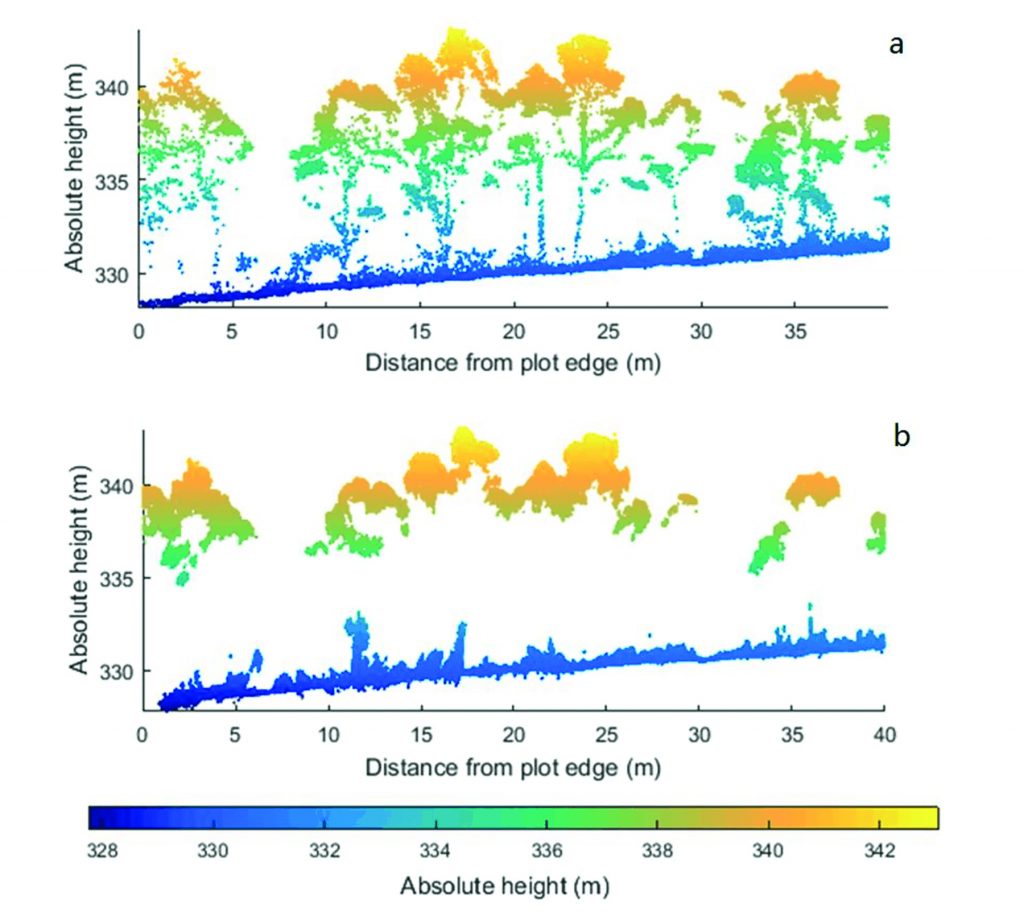
While LIDAR can provide more detail underneath denser vegetation, both photogrammetry (lower graph) and LIDAR (top graph) can generate terrain models underneath sparse vegetation where the ground is partially visible from the air. (The data shown in this graphic was captured at 30 meters above the ground.)
Photogrammetry and LIDAR Applications
For most missions, 3D results achievable with photogrammetry are similar to those obtained with LIDAR, but with better accuracy and greater versatility, e.g., photorealistic outputs, thanks to the high-resolution visual data. There are some applications—specifically featuring power lines or large areas of dense forest canopy—where the higher expense of LIDAR for airborne missions is justified. Let’s look at the evidence for this across a range of actual applications.
Topographical maps featuring light vegetation (sparse tree stands or open canopy) are best surveyed with high-resolution RGB data capture. The resolution and photorealistic results are useful in cases like wildfire management in residential areas and have been used by some of the world’s largest urban fire and rescue services since the information serves many stakeholders who need a real view of what’s happened.
Topographical maps with medium vegetation can be obtained via a combination of photogrammetry and a method to capture the ground below the vegetation. To capture the additional information below the vegetation, ground survey methods or aerial LIDAR can be used. The combination with ground survey methods keeps the price down while guaranteeing high accuracy plus the resolution and photorealistic results available through photogrammetry.
While LIDAR can provide more detail underneath denser vegetation, both photogrammetry and LIDAR can generate terrain models underneath sparse vegetation where the ground is partially visible from the air.
Large-scale topographical maps featuring heavy vegetation are best acquired via manned airborne LIDAR. A digital terrain model (DTM) of the forest ground provides useful information for project planning in construction (e.g., the planning of new roads), forest biomass or detailed information on vegetation and habitats via topography and underlying terrain, applications falling under these circumstances will always require LIDAR at least in part to normalize topographical data.
Typically, state agencies try to maintain reasonably accurate digital terrain models (DTMs) of the forest grounds. For these kinds of large-scale projects with low resolution requirements, manned airborne LIDAR is the most cost-effective option available. If a more accurate or up-to-date DTM of a small forest is needed, a traditional ground survey will be the cheapest option available, yet lightweight drone LIDAR might fill a niche in-between.
Bare-earth mining, volumetric and natural resource surveys are best handled by high-end RGB payloads. Even massive surveys are ideal with the right drone and RGB camera. On top of this, photogrammetry is cost effective and saves time not only to capture and process data related to cut and fill volumes, stockpile assessments and status reports, but also to share this information and reconcile with contractors and stakeholders.
Power line surveys for vegetation control can be done with LIDAR or high-resolution photogrammetry and powerline extraction features on software like Pix4Dsurvey. For the sake of photorealism, price, and workflow, I recommend the latter option. Research is ongoing around photogrammetry as a go-to, cost-effective solution.
Powerline pole tower inspection benefits from live video inspection with a multicopter carrying an RGB or thermal payload. These are usually relatively small areas that multicopters can maneuver around and take oblique shots of easily and safely. With this method, you get all information within a very short amount of time. Zoom cameras allow detailed inspection that cannot be offered by photogrammetry or LIDAR..
Rail track inspection is still most often carried out from the ground—by a train equipped with ultrasonic, LIDAR, and visual sensors. Inspection from the air with either photogrammetry or aerial LIDAR is gaining more and more interest but both methods are in early stages. High-resolution photogrammetry offers data that avails outputs with all of the essential details accurately and autonomously while saving time. Plus the photorealism adds an element of easy identification and versatility that can answer to a range of questions.
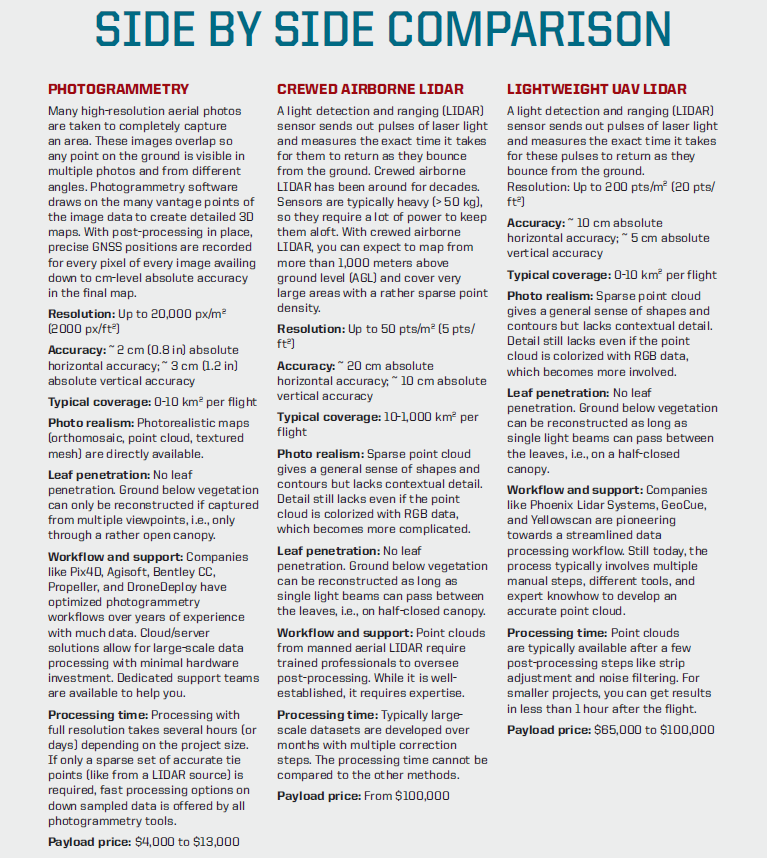
City mapping with vertical structures requiring 3D vantage points has been widely demonstrated with photogrammetry based on imagery captured with a payload featuring oblique capabilities. For cityscapes with many high-rises and intense levels of vertical detail, multicopters work well, although their ability to cover wide-spread areas per flight is compromised. VTOL drones carrying oblique payloads can still capture wide areas and achieve impressive vertical accuracy.
Operational considerations
The difference between photogrammetry and LIDAR grows when considering operational and logistical factors. To generate quality results, a LIDAR system requires all of its components to work perfectly in sync. Small gaps or errors in sensor measurements can lead to significant errors in outputs. Or worse, outputs that “look” right but are not. Techniques like ground control points (GCPs), which are useful in photogrammetry to correct issues, are harder to implement with LIDAR. Most of the time, the only solution for erroneous LIDAR data is to repeat flights.
LIDAR projects require an expert who understands the workflow and details of each subsystem and can recognize consistent and accurate data.
In contrast, photogrammetry-based workflows are more forgiving. The redundancy created by multiple, overlapping images of the same point on the ground enables error correction during processing and translates to high-accuracy outputs, even in non-ideal conditions or operations. The shorter learning curve for drone-based photogrammetry (even for operators with no prior experience), leads to greater flexibility and cost-effectiveness.
The ease of use of photogrammetry solutions like the WingtraOne translates into greater operational flexibility, the ability to deploy multiple systems to cover distributed sites, greater frequency of captures, and overall reduced costs.
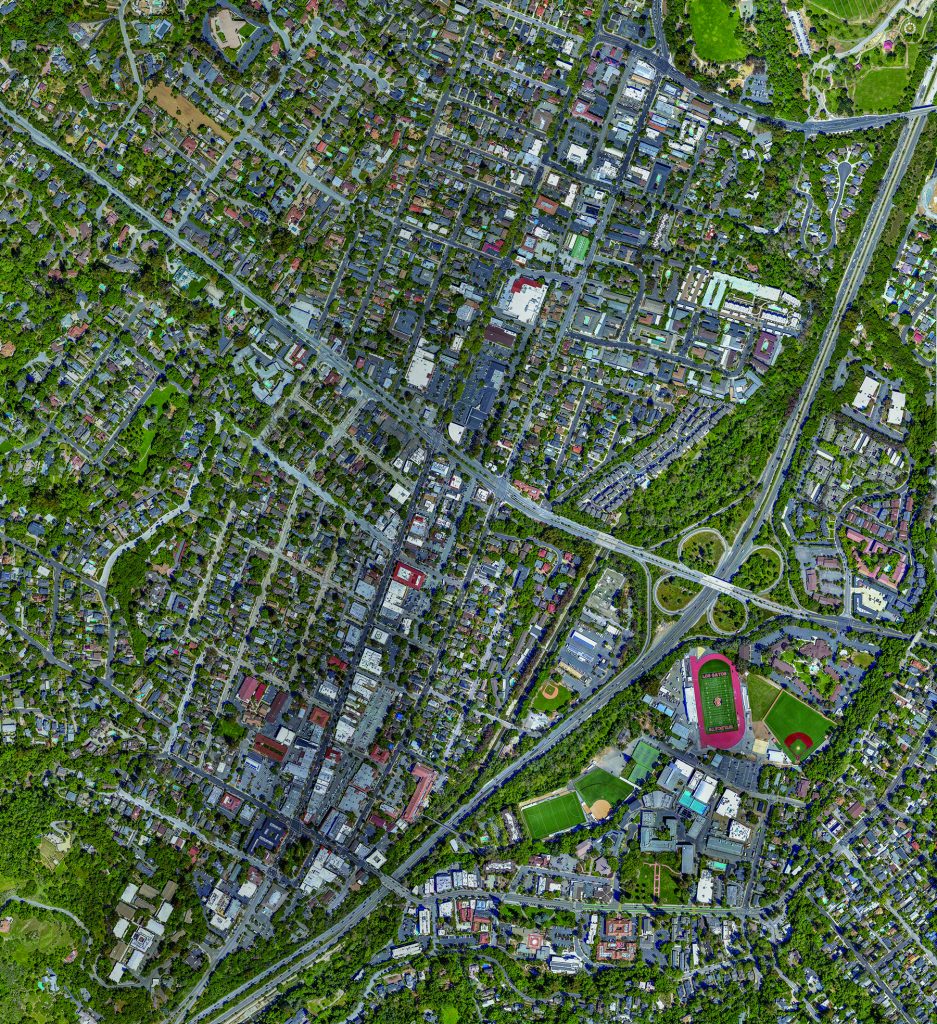
Photogrammetry allows the creation of accurate 3D maps of large areas. Photogrammetry outputs also include high-resolution visual data in full color for every point on the map to aid in the interpretation.
Final thoughts
We have explored the differences between how photogrammetry and LIDAR work and the similarities in their outputs and learned about situations where each technology can be best applied. And while some specific applications might justify the cost and complexity of LIDAR, photogrammetry can meet most of the everyday challenges presented across a range of projects and industries, providing exceptional accuracy and stunningly detailed maps, available on demand and with minimal expertise overhead.
So if you don’t need what LIDAR uniquely provides—specifically to mid- or large-scale forests with heavy but penetrable canopy—you can do more using photogrammetry coupled with a professional drone for significantly less money and complexity.



















